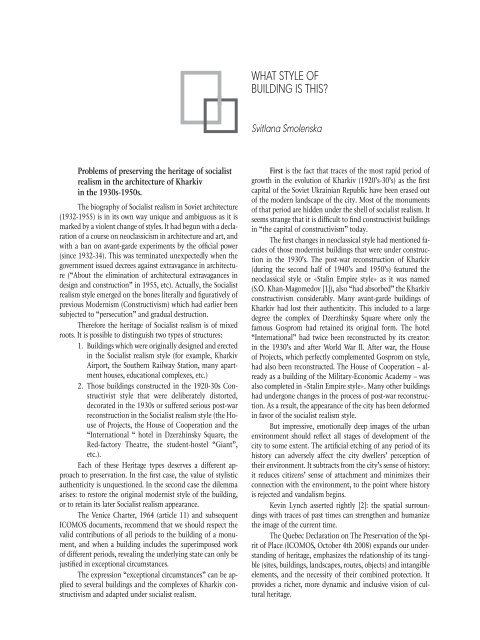Show publication content!
Show publication content!
Show publication content!
Erfolgreiche ePaper selbst erstellen
Machen Sie aus Ihren PDF Publikationen ein blätterbares Flipbook mit unserer einzigartigen Google optimierten e-Paper Software.
Problems of preserving the heritage of socialist<br />
realism in the architecture of Kharkiv<br />
in the 1930s-1950s.<br />
The biography of Socialist realism in Soviet architecture<br />
(1932-1955) is in its own way unique and ambiguous as it is<br />
marked by a violent change of styles. It had begun with a declaration<br />
of a course on neoclassicism in architecture and art, and<br />
with a ban on avant-garde experiments by the offi cial power<br />
(since 1932-34). This was terminated unexpectedly when the<br />
government issued decrees against extravagance in architecture<br />
(“About the elimination of architectural extravagances in<br />
design and construction” in 1955, etc). Actually, the Socialist<br />
realism style emerged on the bones literally and fi guratively of<br />
previous Modernism (Constructivism) which had earlier been<br />
subjected to “persecution” and gradual destruction.<br />
Therefore the heritage of Socialist realism is of mixed<br />
roots. It is possible to distinguish two types of structures:<br />
1. Buildings which were originally designed and erected<br />
in the Socialist realism style (for example, Kharkiv<br />
Airport, the Southern Railway Station, many apartment<br />
houses, educational complexes, etc.)<br />
2. Those buildings constructed in the 1920-30s Constructivist<br />
style that were deliberately distorted,<br />
decorated in the 1930s or suffered serious post-war<br />
reconstruction in the Socialist realism style (the House<br />
of Projects, the House of Cooperation and the<br />
“International “ hotel in Dzerzhinsky Square, the<br />
Red-factory Theatre, the student-hostel “Giant”,<br />
etc.).<br />
Each of these Heritage types deserves a different approach<br />
to preservation. In the fi rst case, the value of stylistic<br />
authenticity is unquestioned. In the second case the dilemma<br />
arises: to restore the original modernist style of the building,<br />
or to retain its later Socialist realism appearance.<br />
The Venice Charter, 1964 (article 11) and subsequent<br />
ICOMOS documents, recommend that we should respect the<br />
valid contributions of all periods to the building of a monument,<br />
and when a building includes the superimposed work<br />
of different periods, revealing the underlying state can only be<br />
justifi ed in exceptional circumstances.<br />
The expression “exceptional circumstances” can be applied<br />
to several buildings and the complexes of Kharkiv constructivism<br />
and adapted under socialist realism.<br />
WHAT STYLE OF<br />
BUILDING IS THIS?<br />
Svitlana Smolenska<br />
First is the fact that traces of the most rapid period of<br />
growth in the evolution of Kharkiv (1920’s-30’s) as the fi rst<br />
capital of the Soviet Ukrainian Republic have been erased out<br />
of the modern landscape of the city. Most of the monuments<br />
of that period are hidden under the shell of socialist realism. It<br />
seems strange that it is diffi cult to fi nd constructivist buildings<br />
in “the capital of constructivism” today.<br />
The fi rst changes in neoclassical style had mentioned facades<br />
of those modernist buildings that were under construction<br />
in the 1930’s. The post-war reconstruction of Kharkiv<br />
(during the second half of 1940’s and 1950’s) featured the<br />
neoclassical style or «Stalin Empire style» as it was named<br />
(S.О. Khan-Magomedov [1]), also “had absorbed” the Kharkiv<br />
constructivism considerably. Many avant-garde buildings of<br />
Kharkiv had lost their authenticity. This included to a large<br />
degree the complex of Dzerzhinsky Square where only the<br />
famous Gosprom had retained its original form. The hotel<br />
“International” had twice been reconstructed by its creator:<br />
in the 1930’s and after World War II. After war, the House<br />
of Projects, which perfectly complemented Gosprom on style,<br />
had also been reconstructed. The House of Cooperation – already<br />
as a building of the Military-Economic Academy – was<br />
also completed in «Stalin Empire style». Many other buildings<br />
had undergone changes in the process of post-war reconstruction.<br />
As a result, the appearance of the city has been deformed<br />
in favor of the socialist realism style.<br />
But impressive, emotionally deep images of the urban<br />
environment should refl ect all stages of development of the<br />
city to some extent. The artifi cial etching of any period of its<br />
history can adversely affect the city dwellers’ perception of<br />
their environment. It subtracts from the city’s sense of history:<br />
it reduces citizens’ sense of attachment and minimizes their<br />
connection with the environment, to the point where history<br />
is rejected and vandalism begins.<br />
Kevin Lynch asserted rightly [2]: the spatial surroundings<br />
with traces of past times can strengthen and humanize<br />
the image of the current time.<br />
The Quebec Declaration on The Preservation of the Spirit<br />
of Place (ICOMOS, October 4th 2008) expands our understanding<br />
of heritage, emphasizes the relationship of its tangible<br />
(sites, buildings, landscapes, routes, objects) and intangible<br />
elements, and the necessity of their combined protection. It<br />
provides a richer, more dynamic and inclusive vision of cultural<br />
heritage.



